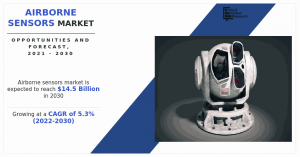USD 14.5 Billion Airborne Sensors Market Worth by 2030, CAGR of 5.3% | Industry Demand and Opportunities
Surge in threats from international terrorists & increase in defense, military budgets for consolidating the national security in developing & developed nations
WILMINGTON, DE, UNITED STATES, June 27, 2025 /EINPresswire.com/ -- Airborne sensors market size generated $9.2 billion in 2021, and is estimated to generate $14.5 billion by 2030, witnessing a CAGR of 5.3% from 2022 to 2030.The growth of the global airborne sensors market is propelled by rising international terrorism threats and increasing defense and military expenditures aimed at enhancing national security across both developed and developing nations. Furthermore, advancements in technology, continuous product innovations, and growing investments in research and development are expected to create new growth opportunities in the near future.
Download Report (228 Pages PDF with Insights, Charts, Tables, Figures) at https://www.alliedmarketresearch.com/request-sample/A16504
Extensive demand for airborne sensors in the defense sector may act as the major driving factor for the market.
An airborne sensor is a type of operator that can gather the information from airborne platforms; it can be manned or unmanned. It is mostly used for the missions such as military, public safety, academic and commercial remote sensing purposes. In defense sector, airborne sensors support surveillance, intelligence, and reconnaissance collection operations. Also, it can be used in Combat Search & Rescue (CSAR) and tactical combat operations. Moreover, signal intelligence plays vital role in government and defence authorities. Moreover, combination of signal intelligence and airborne sensor helps in detecting, identifying, locating, and tracking the full-time spectrum awareness and intelligence to national as well as a tactical user.
The airborne sensor industry will be witnessing a massive growth mainly because of the increase in adoption of airborne sensors in the defense sector. Airborne sensors can support surveillance, intelligence, and reconnaissance collection operations in military missions.
Buy This Research Report: https://www.alliedmarketresearch.com/airborne-sensors-market/purchase-options
The global airborne sensors market is segmented on the basis of type, application, and region. By type, the market has been divided into non-scanning and scanning airborne sensors. By application, the analysis has been divided into defense aircraft, commercial aircraft, and others. By region, the market is analysed across North America, Europe, Asia-Pacific, and LAMEA.
Based on region, North America accounted for the highest market share in terms of revenue in 2021, holding more than one-fourth of the global airborne sensors industry, and is expected to maintain its dominance in terms of revenue by 2030. This is due to rise in public spending on imaging software and integration of smart sensing technologies by leading tech companies such as Uber and Tesla for development of self-driving cars. However, Asia-Pacific is estimated to register the fastest CAGR of 5.9% during the forecast period, owing to surge in demand for improved technologies in radars, electro-optics/infrared (EO/IR) sensors, and others. In addition, the development of next-generation aircrafts and increase in defense contracts supplement the market growth.
For Purchase Enquiry: https://www.alliedmarketresearch.com/purchase-enquiry/A16504
Leading Market Players
Hexagon
Thales Group
Raytheon Technologies
Lockheed Martin Corporation
information systems laboratories
teledyne optech
General Dynamics Corporation
Honeywell International Inc.
ITT Inc.
AVT Airborne Sensing GmbH
Trending Reports:
Ultralight Aircraft Market: https://www.alliedmarketresearch.com/ultralight-aircraft-market
Unmanned Aerial Vehicles (UAVs) Simulation Market: https://www.alliedmarketresearch.com/unmanned-aerial-vehicles-uavs-simulation-market-A08545
Aircraft Window Frame Market: https://www.alliedmarketresearch.com/aircraft-window-frame-market-A31492
David Correa
Allied Market Research
+ 1800-792-5285
email us here
Visit us on social media:
LinkedIn
Facebook
YouTube
X
Legal Disclaimer:
EIN Presswire provides this news content "as is" without warranty of any kind. We do not accept any responsibility or liability for the accuracy, content, images, videos, licenses, completeness, legality, or reliability of the information contained in this article. If you have any complaints or copyright issues related to this article, kindly contact the author above.
Medical Supplierz Showcases Cutting-Edge Medical Equipment from Verified Global Suppliers
Acupressure for Nurses Course Offers 6 CNEs from AHNA
Cook Travel Becomes Trailblazer, Accepting Bitcoin for Tours and Airline Tickets
Więcej ważnych informacji
 Jedynka Newserii
Jedynka Newserii

 Jedynka Newserii
Jedynka Newserii

Handel

Komisja Europejska chce wprowadzić ujednolicone przepisy dotyczące wyrobów tytoniowych. Europosłowie mówią o kolejnej nadregulacji
Ministerstwo Zdrowia opracowało nowy projekt przepisów wprowadzających kolejne zakazy dotyczące wyrobów tytoniowych – całkowitą eliminację e-papierosów oraz zakaz aromatów w woreczkach nikotynowych. Najprawdopodobniej w ciągu kolejnych dwóch–trzech lat Polska będzie musiała implementować nową dyrektywę dotyczącą wszystkich produktów tytoniowych, nad którym niebawem ma rozpocząć prace Komisja Europejska. Europosłowie mówią o ryzyku chaosu legislacyjnego, nadregulacji i wskazują na zagrożenia związane z proponowaną podwyżką akcyzy.
Konsument
Za trzy miesiące ruszy w Polsce system kaucyjny. Wątpliwości budzą kwestie rozliczeń i podatków

Zaledwie trzy miesiące zostały do startu systemu kaucyjnego w Polsce. Kaucje obejmą szklane i plastikowe butelki oraz puszki z napojami. To duża zmiana dla producentów napojów, sklepów i konsumentów oraz pośredniczących w zbiórce operatorów systemów kaucyjnego. Na razie przepisy są na tyle niedoprecyzowane, że budzą wiele wątpliwości w kwestii rozliczania podatków czy rozliczeń z operatorami. Producenci będą musieli płacić podatek od niezwróconych butelek, co zwiększy ich koszty.
Transport
Rośnie skala agresji na polskich drogach. Problemem jest nie tylko nadmierna prędkość, ale też jazda na zderzaku

Za kilka dni zaczynają się wakacje, czyli statystycznie najniebezpieczniejszy czas na drogach. Wśród głównych przyczyn takich zdarzeń na prostych odcinkach drogi są nadmierna prędkość i jazda na zderzaku. Zarządca autostrady A4 Katowice–Kraków w ramach kampanii „Nie zderzakuj. Posłuchaj. Jedź bezpiecznie” zwraca uwagę na zjawisko agresji na polskich drogach i przypomina, że bezpieczeństwo zaczyna się od osobistych decyzji kierowcy.
Partner serwisu
Szkolenia

Akademia Newserii
Akademia Newserii to projekt, w ramach którego najlepsi polscy dziennikarze biznesowi, giełdowi oraz lifestylowi, a także szkoleniowcy z wieloletnim doświadczeniem dzielą się swoją wiedzą nt. pracy z mediami.










.gif)

 |
| |
| |
|